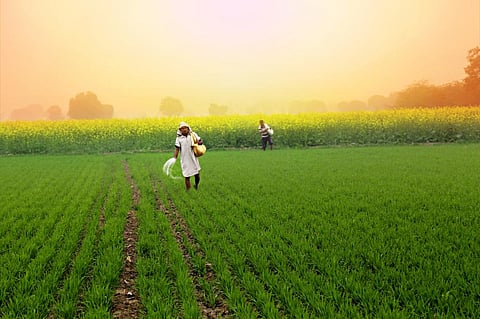Analysing climate-induced productivity growth in Indian agriculture
Technology can be a boon for agriculture in India, especially when climate hazards sound the death knell for acres of mature crops each year. A comprehensive analysis of the climate dynamics shaping the country’s farm productivity unfurls the policy developments required for the sector.
Considering exogenous weather shocks, agricultural productivity growth for India was estimated over time and across states. It is further decomposed into technical progress, technical efficiency change and scale efficiency change. The findings were published in the journal Environmental Challenges recently.
Total factor productivity (TFP) growth, as a measure of productivity growth, was found to be 0.688 per cent (rounded) on average from 1990-2015, consisting of 0.004 per cent of technical progress, 0.384 per cent of the change in technical efficiency and 0.293 per cent of scale operation.
TFP growth rate initially dropped, falling from 1.192% in 1991 to 0.809% in 1993 but exhibited a sharp increase of 7.317% from 1993-1995.
It again declined from 0.476% in 1995 to 0.250% in 2000. Though technical progress increased over the period, the decline in output growth was observed primarily due to the deterioration in scale efficiency.
From 2000-2006, TFP growth exhibited an ascending trend, which rose from 0.250% to 1.793% with the onset of the National Agricultural Policy. But a steep drop in productivity growth is marked from 2004-2006, induced by deterioration in technical efficiency and the scale of operation in relevant years.
In 2006, productivity growth was estimated to be 1.793%, followed by a descending trend from 2007-2015, with limited fluctuations.
Output growth falling from 0.588% in 2007 to 0.348% in 2015 was attributable to a decline in scale operation. Moreover, the time period studied provided evidence of several reforms that could have influenced the productivity growth of Indian agriculture.
In addition to determinants of TFP growth, weather characteristics also influenced the obsolescence of technology and affected the TFP growth of climate-vulnerable regions.
Tamil Nadu was estimated to have the highest rate of output growth, followed by Himachal Pradesh, Andhra Pradesh, Rajasthan, Telangana and Gujarat. The main driver of this large output growth in Tamil Nadu and Himachal Pradesh was an advancement in scale efficiency during the relevant period compared to other states.
Assam, Punjab and Jharkhand were found with low productivity scores, while Karnataka had the lowest productivity growth of -0.873% among all states, owing to a decline in scale efficiency over the period.
The output falling short of the frontier level was observed because of inefficient resource use and frequent crop failure due to environmental degradation. Most output growth was quantified due to changes in technological efficiency, while yearly and cross-state productivity growth inequalities were attributable to differences in scale components.
Turning to the disintegrated determinants of TFP growth, overall technical progress did not show a significant difference over the period, whereas changes in technical efficiency showed a high degree of volatility.
The scale component showed a descending trend over time and followed the trend of TFP growth. Tamil Nadu ranked first with a scale effect and technical efficiency, and Bihar led the way with technical progress of 0.005%.
Himachal Pradesh got the lowest score for technical progress and change in technical efficiency, while Karnataka got the lowest score for incompetent resource utilisation, with a scale effect of -1.174%.
Heterogeneous production performance across states was observed and was clearly due to disparities in physical endowments, environmental conditions and institutional traits.
The effect of climate on agricultural productivity growth underscored the efficiency aspect at the national level, as well as time-varying differences in productivity at the state level, highlighting technical progress, change in technical efficiency, and scale effects discovered as determinants through the deconstruction of TFP growth.
Differences in regional performance suggested that adaptation needs should differ across states. States that initially benefited from the post-green revolution showed a decline in productivity growth due to scale inefficiency, where the mean technical efficiency score exhibited significant volatility over the period, with states like Punjab, Kerala, Himachal Pradesh and Assam. The state-wise need for the adoption of cutting-edge technology with improved resource allocation is thus reinforced.
Investment in technological advancements, research and development are required to improve the agricultural position of India. Given scale effects are a major contributor to the decline in output growth in some states, improving scale operation should be accomplished by strengthening management skills, encouraging the efficient use of available inputs and regulating structural constraints (like farm size, age and weather elements). Considering that marginal farmers are unable to afford the cost of modern inputs and often fail to switch to prevailing technologies, advances in trades that could increase technical efficiency and scale operation are suggested, improving profitability.
Government policy should encourage region-specific investments that bring newly developed technologies and improve the efficiency of existing technology. State-specific policy initiatives that allow each state’s agricultural production to reach its full potential are more likely to succeed than broad economic reforms. Following climate importance in crop productivity, environmentally friendly and climate-resilient farming practices such as crop diversification should be promoted to boost rural agriculture productivity and resilience.
Policymakers could strengthen the infrastructure base, particularly in rural areas, which is critical for improving agricultural performance. This is plausible given the vast potential for optimising the available resource base. It is also suggested that policies be differentiated to account for regional differences.
Souryabrata Mohapatra, University of Auckland.
Views expressed are the author’s own and don’t necessarily reflect those of Down To Earth.


